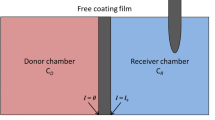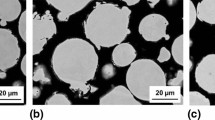Abstract
The explicit finite difference form of the diffusion equation has been used to describe a two-phase binary diffusion problem which includes a constant surface flux boundary condition, a concentration-dependent diffusion coefficient, and dimensional change due to both additions of material and nonideal solution behavior. The ξγ coordinate system, containing an equal number of mols of the substrate component per increment, has been employed to simplify the mathematical form of the diffusion equation. At the two-phase interface a Lagrangian extrapolation has been employed in conjunction with the finite difference equations to determine solute concentration and flux as well as interface movement. Results of sample calculations for the α and β phases formed when a constant flux of aluminum is admitted to a copper surface at 850°C are presented graphically. Results include concentration profiles, surface concentration as a function of time, and movement of theα-β interface for a flat plate and for a cylinder. This treatment is applicable to any two-phase binary system wherein the arrival rate of solute atoms at the solvent surface, either by ionic transport in high-temperature electrodiffusion cells or from the vapor phase, is equal to the diffusion rate into the surface.
Similar content being viewed by others
References
R. L. Benedetti and D. L. Creighton:Met. Trans., 1970, vol. 1, pp. 3383–87.
B. J. Chao and J. C. Chato:Advanced Heat Transfer, pp. 306–11, University of Illinois, Urbana, 1967.
W. Jost:Diffusion in Solids, Liquids and Gases, pp. 69–72, Academic Press, N.Y., 1960.
L. S. Castleman:Nucl. Sci. and Eng., 1958, vol. 4, pp. 209–26.
D. D. Van Horn:Trans. ASM, 1959, vol. 51, pp. 185–98.
C. Atkinson:Acta Met., 1968, vol. 16, pp. 1019–22.
A. G. Guy, V. Leroy, and T. B. Lindemer:Trans. ASM, 1966, vol. 59, pp. 517–34.
W. D. Murray and F. Landis:Trans. ASME Series C, 1959, vol. 81, pp. 106–12.
M. Hansen:Constitution of Binary Alloys, 2nd ed., p. 85, McGraw-Hill Book Company, NX, 1958.
O. D. Sherby and M. T. Simnad:Trans. ASM, 1961, vol. 54, pp. 227–40.
J. Crank:The Mathematics of Diffusion, pp. 58, 74, Oxford University Press, Oxford, England, 1956.
H. W. Carslaw and J. C. Jaeger:Conduction of Heat in Solids, pp. 75, 203, Oxford University Press, Oxford, England, 1947.
R. A. Tanzilli and R. W. Heckel:Trans. TMS-AIME, 1968, vol. 242, pp. 2313–31.
J. Crank and P. Nicolson:Proc. of Cambridge Phil Society, 1947, vol. 43, pp. 50–64.
Author information
Authors and Affiliations
Rights and permissions
About this article
Cite this article
Creighton, D.L., Benedetti, R.L. The solvent-fixed coordinate system applied to two-phase diffusion coatings resulting from a constant surface flux of solute. Metall Trans A 8, 1721–1726 (1977). https://doi.org/10.1007/BF02646875
Received:
Issue Date:
DOI: https://doi.org/10.1007/BF02646875




